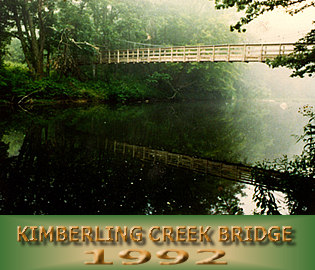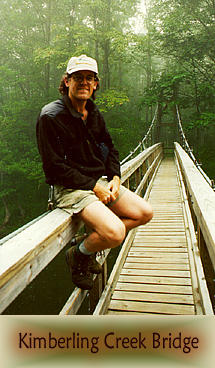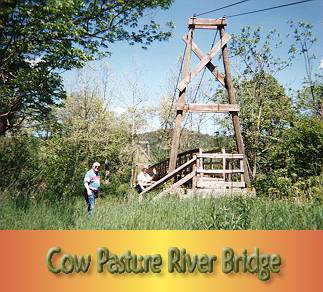|
Kimberling
Creek Suspension Bridge &
Cow Pasture
River Suspension Bridge, 1992
Appalachian
Trail, Blacksburg
Ranger District, Jefferson National Forest, VA
Deerfield
Ranger District, George Washington National Forest, VA

|
Satellite view of Bridge Location. View Larger Map |
 USE:
Pedestrian
USE:
Pedestrian
SPAN:
150'
TRAVEL
WIDTH : 3'
TOWERS:
34' tall, CCA treated southern yellow pine.
ANCHORS:
14 cy concrete deadmen w/ 1-1/2" ASTM A 307 rod each mainline.
MAINLINES:
1", ASTM A 603, 7x7 Wire Rope

The Kimberling Creek
Bridge is located on the Appalachian Trail, in southwest Virginia, near Marion.
At the bridge crossing, Kimberling Creek is a lazy, bucolic stream overstoried
with oak, hickory, ash and other eastern hardwoods. It is a great spot
to spend a quiet afternoon hiking, picnicking and swimming, and the bridge is
renowned among AT through-hikers because of its proximity to Trent's Grocery,
a popular spot for rest, refreshment, and re-supply.
The Cow Pasture
River Suspension Bridge is located on the Deerfield Ranger District, George
Washington National Forest, near Staunton, VA. It provides major recreational
access to Forest Service land that previously was inaccessible for parts of
each year due to high flood waters.
 The Kimberling Creek and Cow Pasture Bridges were our first cable bridges, constructed
for the U.S. Forest Service in the early 90s. They are nearly identical bridges,
based on a traditional design supplied to the Forest Service by the National
Park Service.
The Kimberling Creek and Cow Pasture Bridges were our first cable bridges, constructed
for the U.S. Forest Service in the early 90s. They are nearly identical bridges,
based on a traditional design supplied to the Forest Service by the National
Park Service.
The treated timber bridge towers are set in concrete abutments and the mainlines are anchored
to concrete deadmen using fabricated steel rods. Cable suspenders support
a floor beam and diaphragm-braced stringer deck system. The railing consists
of dimensional horizontal rails affixed to 4 x 4 posts, which in turn are attached
to the stringer box frame. The bridges were erected by pre-assembling
the tower poles on the ground and tilting them into position, then casting the
abutment concrete in place. Skylines were used for erection of the mainspan,
including installation of suspenders, floor beams, and stringers.
The photos on the right of
this page are of bridge builder Carroll Vogel at Kimberling Creek Bridge three years after construction,
and of bridge builder Mack McFarland at Cow Pasture River, also about three years after construction.
The photo gallery contains construction sequence photos for Kimberling Creek Bridge only.





